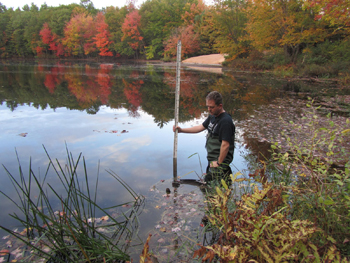Connecting Land Cover and Climate to Sebago Lake Drainage Network Processes
 Institution: University of Maine
Institution: University of Maine
Sponsor: Maine Water Resources Research Institute through the Mitchell Center
This project seeks to quantify connections between physiographic setting, land cover, climate and hydraulic conditions within tributaries draining to Sebago Lake in southern Maine. The interest in the connections is based on the assumption that changes to the tributaries resulting from human activities has implications to water quality and aquatic habitat conditions in the lake and its surrounding satellite ponds. More specifically, changes to hydrology affect surface flow patterns that govern the movement of materials and chemical constituents through the lake watershed. The work will leverage data and results from an ongoing hydrologic evaluation of the lake watershed, using the information to estimate tributary hydraulic conditions and the mobility of bottom sediment. The hydrologic simulations will create runoff scenarios driven by specified land cover and climate conditions that conform to informed estimates of past, present and future conditions in the region. The connections between landscape conditions, hydrology, drainage network conditions and water quality loads are at the heart of nonpoint source pollution concerns throughout the Northeastern U.S.A. This project seeks to advance understanding of the connections in glaciated terrain to help guide land use planning, nonpoint source pollution management, aquatic habitat conservation, and public water supply protection.
Team leader: Sean Smith, School of Earth and Climate Sciences
